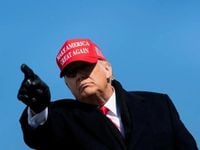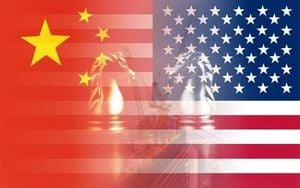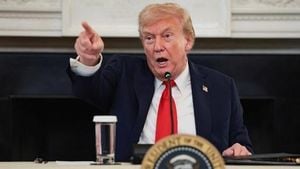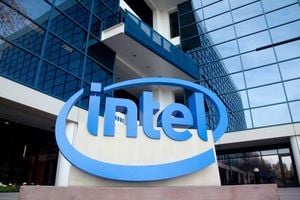On a humid September morning in Washington, D.C., the familiar blue tent that had stood watch over Lafayette Park for more than forty years was suddenly gone. For decades, the White House Peace Vigil—a small, persistent protest site just steps from the seat of American power—had weathered storms, presidential transitions, and the slow march of history. But on Sunday, September 7, 2025, federal law enforcement officials dismantled the vigil, following a direct order from President Donald Trump just two days earlier.
The removal marked the end of what many believe to be the longest continuous anti-war protest in U.S. history. The vigil was first established in 1981 by activist William Thomas, who sought to promote nuclear disarmament and an end to global conflict. Since then, a rotating cast of volunteers—some of whom made the site their life’s work—had kept the vigil alive, manning it around the clock to ensure it was never left unattended and thus vulnerable to removal.
“Twenty-four hours a day, seven days a week, for 44 years, someone has sat here, advocating for people around the world who we don’t know. Advocating for human rights. Advocating for peace,” said Will Roosien, a 24-year-old volunteer who was present when officers arrived early Sunday morning. According to The Washington Post, Roosien refused to leave when police told him he had thirty minutes to clear a tarp he had been using for shelter. He was detained as officers dismantled the tent—an act he called "a disgrace."
The White House confirmed the removal, telling the Associated Press that the vigil had become "a hazard to those visiting the White House and the surrounding areas." The dismantling, officials said, was part of a broader Trump administration initiative to clear homeless encampments and "beautify" the nation’s capital, following an executive order issued by Trump in March 2025. The administration’s federal takeover of policing in Washington, D.C., had begun the previous month, drawing both praise and criticism from various quarters.
The move to remove the vigil was set in motion during a White House event on Friday, September 5, 2025. Brian Glenn, a correspondent for the conservative network Real America’s Voice, drew Trump’s attention to the tent, describing it as an “eyesore” and alleging it had shifted from its original anti-nuclear message to a more general anti-American and anti-Trump stance. "Just out front of the White House is a blue tent that originally was put there to be an anti-nuclear tent for nuclear arms – it’s kind of morphed into an anti-America sometimes, anti-Trump at many times," Glenn said. Trump, who said he was previously unaware of the vigil, responded immediately: “Take it down. Take it down today, right now.”
Volunteers and long-time stewards of the vigil, including Philipos Melaku-Bello, were quick to defend the protest as a constitutionally protected exercise of free speech. Melaku-Bello, who has manned the vigil for years, told the Associated Press, “The difference between an encampment and a vigil is that an encampment is where homeless people live. As you can see, I don’t have a bed. I have signs and it is covered by the First Amendment right to freedom of speech and freedom of expression.” Melaku-Bello further insisted that officials had mischaracterized the vigil as a homeless encampment in order to justify its removal under Trump’s agenda. “They’re choosing to call a place that is not an encampment an encampment just to fit what is in Trump’s agenda of removing the encampments,” he said.
Others, like Neal Cousins and Shell—two additional spokespersons for the vigil—echoed Melaku-Bello’s sentiments. Speaking to the Washington Examiner, Shell recounted how officials had removed the rain structure that protected their books and tarps but left the protesters and their voices in place. “They didn’t remove us or our voices, so we’re still here,” she said defiantly. Cousins cited the First Amendment freedoms of press, religion, and assembly as justification for the vigil’s continued presence, even as its physical structure was being dismantled.
Despite the removal, the spirit of the protest persisted. Volunteers partially rebuilt the vigil on Sunday, according to Melaku-Bello, and there were indications that legal battles over the right to protest in Lafayette Park would soon follow. “I expect the battle over the vigil to wind up in court,” Melaku-Bello told Law Dork, an independent news outlet.
President Trump, meanwhile, appeared to believe the matter settled. Speaking at the Museum of the Bible on Monday, September 8, he claimed the vigil was gone. “We had a blue tent right on Lafayette, and they seemed to have a permit,” Trump said. “And one of the fake news media was asking me the other day, ‘What about the blue tent?’ What blue tent? We got it down very quickly. It’s down. It wasn’t easy. People chained themselves to a tree and this and that, but that’s OK.” Yet, as the Washington Examiner reported, while the blue tent was indeed gone, an oversized red umbrella had taken its place, and the protesters remained undeterred.
The controversy over the vigil’s removal has drawn a range of political responses. Republican Congressman Jeff Van Drew of New Jersey, for instance, wrote to the Department of the Interior criticizing the vigil as a public safety hazard and a blight on one of the nation’s most iconic parks. “Nothing in the constitution guarantees the right to erect permanent structures and occupy public land day after day, year after year, in a manner that creates public safety hazards, degrades the appearance of one of our most iconic parks, and burdens both [the capital] and the National Park Service,” Van Drew argued in his letter. “This isn’t ‘free speech.’ This is a failure of enforcement.”
Supporters of the vigil, however, see its removal as a violation of civil rights and a troubling precedent for free expression in the nation’s capital. Melaku-Bello told the Associated Press he is in touch with attorneys about what he views as a civil rights violation. Volunteers insist that the vigil was never an encampment, that no weapons or rats were found during its dismantling, and that its removal was prompted by political pressure rather than genuine public safety concerns.
For now, the fate of the White House Peace Vigil remains uncertain. Its blue tent may be gone, but the determination of its stewards—and the larger debate over the boundaries of protest and public space in America’s capital—endures. As the sun rose over Lafayette Park on Monday, the protest’s banners and a new red umbrella stood as quiet reminders that even the smallest acts of dissent can leave a lasting mark on history.





